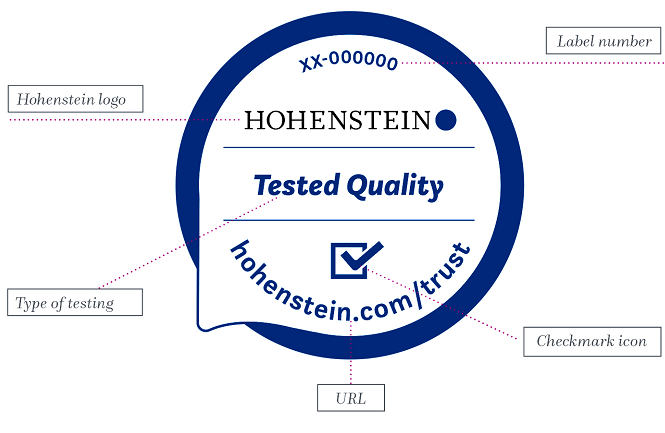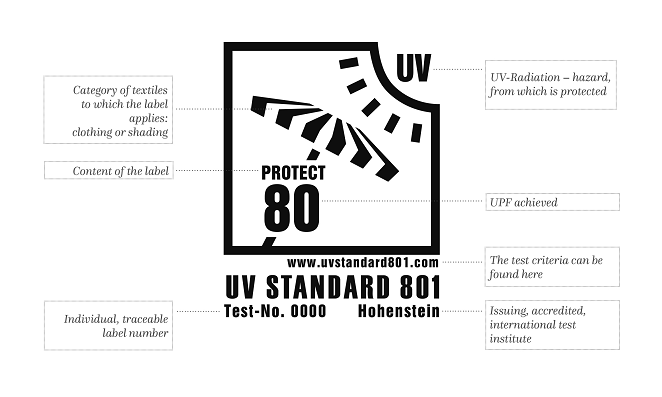Sunny but safe prospects.
We are pleased each day that it shines: our sun. It is important for our vitamin D balance. And it is also lifts our spirits.
However, we must not forget that excessive sun radiation damages our skin and eyes; in the short term through sunburn and in the long term through skin cancer.
Recognise good textile UV protection products.
To be able to protect ourselves from the sun, we need to find the best product, whether it is an item of clothing, for example, a head gear or a shirt, or a shading article, e.g. a parasol. Ideally, these products should provide information about their protection level in their advertising or, at least, in their description.
Labelled products that have been tested and certified by independent third parties such as the Hohenstein Institute are a good choice.
Only trust a unique traceable label that has been given a certificate number, institute and an informative website.
Determination of UPF of clothing and shading materials.
The classification into clothing and shading textiles is initially important as the significant difference in use between textiles worn next to the body and those used at more of a distance must be taken into account. It is thus essential that the purpose of the material is taken into account.
If clothing is designed and manufactured as UV protection clothing or with the intention to protect from natural UV rays, it comes under EU directive 2016/425 on personal protective clothing.
This becomes clear for consumers from the declaration, the name, depiction of UPFs, specification of corresponding standard (e.g. AS/NZS 4399 or UV STANDARD 801), informative illustration etc.
In this case, the product is subject to the CE certification label and must meet specific requirements, e.g. DIN EN ISO 13688, as well as providing proof of UV protection. Compliance with these special requirements is not a subject of the material test to determine the ultraviolet protection factor (UPF).
It must then be decided which test specification you would like to use for your product testing and, if applicable, for certification.
Tested for safety.
In new condition
The test requirements and certification requirements are defined according to the different international standards.
- Australian-New Zealand (AS/NZS 4399)
New, unstretched and dry textiles under the solar spectrum of Melbourne, Australia on January 1st. - European (DIN EN 13758-1)
New, unstretched and dry textiles under the solar spectrum of Albuquerque, New Mexico. - American (AATCC TM 183)
Textiles in a new condition under the solar spectrum of Albuquerque, New Mexico.
Tests of other conditions are possible, however they are not offered by Hohenstein.
For real life
For the UV STANDARD 801, we consider important aspects of use, including stretching of the textile, wetting of clothing, weathering of shading textiles, aging by certain abrasion and washing cycles and many more. We also assume maximum radiation intensity with the solar spectrum in Melbourne, Australia, on January 1st (peak of the Australian summer).
Data for completion
The following applies when using the UV STANDARD 801 or DIN EN 13758-1: In the case of clothing, the tested material may only be used and advertised in tailor made clothing when the essential requirements of sun protective objective are fulfilled concerning typically exposed body locations. This falls to you as our customer and is not subject of the material testing.
In the case of test basis AS/NZS 4399, the tested material may be used if the requirements of the level of body coverage are met as per “4. Body Coverage”. This also falls to you as our customer and is not subject of the material testing.
Lead time (all standards):
- 10 working days
- Express service available on request
Sample quantity UV STANDARD 801:
- At least 1 m² per material and colour, taken across the entire or at least ½ product width
- In the case of certification, a ready-made sample or at least one informative illustration
Sample quantity (other standards and Hohenstein Quality Label):
- At least 50 cm x 50 cm per material and colour, taken across the entire or at least ½ product width
- In the case of certification, a ready-made sample or at least one informative illustration
Hohenstein specials.
Hohenstein is more than just a reliable partner for all standard services in the field of UV protection: we also offer solutions for the individual challenges and preferences of our customers.
Clothing: because so much is at stake.
At the start of the long journey of a product, the right material is a key criterion as well as the style. And at the end is the goal of the journey: the correct labelling of product characteristics. We are by your side with many of our services during the development of your product.
If the UPF determination is only performed on dry textiles in the new condition, information must be provided within the framework of labelling and information as per regulation (EU) 2016/425 on personal protective clothing that the UPF can change under wearing and usage conditions. We are happy to check your drafts in this regard.
Typical usage scenarios can be covered within the framework of the UPF determination. These include, for example:
- Washing of shading (e.g. awnings)
- Industrial washing of clothing (e.g. high-visibility warning clothing)
If other materials than textiles are used for UV protection, we are happy to test the option of UPF determination with modifications.
Our report becomes part of your Technical File.
Shading: innovation in practice.
Shading textiles are an important option as an additional protective measure. Many public standards are restricted solely to clothing. Exception: the UV STANDARD 801. It is currently the best basis for declaring the protective properties of a shading system.
For textiles of this type, it is essential that the purpose is taken into account. This includes weathering as a significant influencing factor for the UPF.
If other materials than textiles for UV protection, we are happy to test the option of UPF determination with modifications.
For reasons of hygiene and appearance, it is increasingly important that shading textiles can also be washed. To remain true to the principle of the worst-case consideration in the sense of the best possible consumer protection, these usage conditions must also be tested when determining the UPF.
Our report becomes part of your Technical File.
Certification: it speaks for itself.
Are you interested in certification? Answers to the following questions are crucial for identifying the correct path:
- Do you have an existing product that you would like to better present to the market?
- Would you like to launch a new product on the market in a targeted and optimised manner and include it in advertising?
We help you to make the decision.
The ability of a product to provide protection is significantly, but not solely, dependent on the material. It is thus important to know which material has been used to create the product. For certification, we initially consider the plausibility of the protection of your product.
Each material quality must be tested individually according to their characteristics. To certify entire catalogues or collections, Hohenstein offers pragmatic but thorough approaches to suit your situation.
However, in all cases, it is important to test suitable materials from the start of your product development. Ready-made goods can also be tested in sufficient availability.
As the decision on certification is of course something special, we monitor the labelling, on the market in advertising and on the product.
And last but not least: So that you do not lose sight of your certifications, we actively and promptly remind you of the renewal of an existing certificate before it expires and thus of the timely submission of the samples for the control test.

